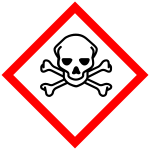| ☠🕱 | |
|---|---|
Skull and crossbones | |
| In Unicode | U+2620 ☠ SKULL AND CROSSBONES U+1F571 🕱 BLACK SKULL AND CROSSBONES |
| Related | |
| See also | U+2623 ☣ BIOHAZARD SIGN U+2622 ☢ RADIOACTIVE SIGN |
A skull and crossbones is a symbol consisting of a human skull and two long bones crossed together under or behind the skull.[1] The design originated in the Late Middle Ages as a symbol of death and especially as a memento mori on tombstones.
In modern contexts, it is generally used as a hazard symbol, usually in regard to poisonous substances, such as deadly chemicals.[1]
It is also associated with piracy and software piracy, due to its historical use in some Jolly Roger flags.
YouTube Encyclopedic
-
1/3Views:1 241 6872 402 00634 505
-
How To Draw A Realistic Skull And Crossbones
-
How To Draw A Skull And Crossbones
-
Skull & Bones: The SECRET SOCIETY You Didn't Know About
Transcription
Military use
The skull and bones are often used in military insignia, such as the coats of arms of regiments.[2][3][4][5][6]
Since the mid-18th century, skull and crossbones insignia has been officially used in European armies as symbols of superiority. One of the first regiments was the Frederick the Great's Hussars in 1741, also known as the "Totenkopfhusaren". From this tradition, the skull became an important emblem in the German army. Identical insignia has been used in the Prussian army after the First World War by Freikorps and in Nazi Germany by the Wehrmacht and the SS. The idea of elitism symbolized by the skull and crossbones has influenced sub- and pop culture and has become part of the fashion industry.[7]
Symbol for poisonous substances
The skull and crossbones has long been a standard symbol for poison.
In 1829, New York State required the labeling of all containers of poisonous substances.[8] The skull and crossbones symbol appears to have been used for that purpose since the 1850s. Previously a variety of motifs had been used, including the Danish "+ + +" and drawings of skeletons.[9]
In the 1870s poison manufacturers around the world began using bright cobalt bottles with a variety of raised bumps and designs (to enable easy recognition in the dark) to indicate poison,[10] but by the 1880s the skull and cross bones had become ubiquitous, and the brightly coloured bottles lost their association.[11]
In the United States, due to concerns that the skull-and-crossbones symbol's association with pirates might encourage children to play with toxic materials, the Mr. Yuk symbol was created to denote poison. However, in 2001, the American Association of Poison Control Center voted to continue to require the skull and crossbones symbol.[11]
Gallery
-
A skull and crossbone arrangement in the Sedlec Ossuary, Czech Republic.
-
Skull and crossbones as a charge in heraldry on the coat of the 8th Lusitania Cavalry Regiment
-
An early 17th-century "plague panel" from Augsburg
-
High voltage sign from Saudi Arabia
-
-
-
A typical Jolly Roger ensign
See also
- Danse Macabre – Artistic motif on the universality of death
- Hazard symbol – Warning symbol on locations or products
- Human skull symbolism – Attachment of symbolic meaning
- Mr. Yuk – Label that indicates poisonous material
- Ossuary – Container for dead remains
- Skull art – Use of skulls and skeletons in art
- Skull and Bones – Secret society at Yale University, US
- Totenkopf – German symbol for skull and crossbones
References
- ^ a b "Dictionary and Thesaurus". Merriam-webster.com.
- ^ "WEARING THE SKULL AND CROSSBONES WITH PRIDE". The British Army.
- ^ Thomas, Nigel (2012). The German Army in World War I (1): 1914–15. Bloomsbury Publishing. ISBN 9781780965512.
- ^ Colburn's United Service Magazine and Naval and Military Journal, Volumen 32. National Library of the Netherlands. 1867. p. 321.
- ^ Hølscher, Joost (2013). Death's Head - Volumen 1 de The History of Uniform. Editions Chamerelle. p. 33. ISBN 9789082032604.
- ^ Joost Hølscher (Author, Illustrator): Death's Head, The History of the Military Skull & Crossbones Badge (The History of Uniform). 1st edition: Éditions Chamerelle 2013, ISBN 978-90-820326-0-4.
- ^ Ruda, Adrian (2023). Der Totenkopf als Motiv. Eine historisch-kulturanthropologische Analyse zwischen Militär und Moden [The skull as a motif. A historical-cultural anthropological analysis between military and fashion] (in German). Böhlau/Brill. ISBN 9783412528904.
- ^ Griffenhagen, George B.; Bogard, Mary (19 November 1999). History of Drug Containers and Their Labels. Amer. Inst. History of Pharmacy. ISBN 9780931292262. Retrieved 19 November 2017 – via Google Books.
- ^ "Antique Poison Bottles". Collectors Weekly. Retrieved 26 February 2022.
- ^ "Poison bottle collection". Antiques Roadshow. BBC One. Retrieved 26 February 2022.
- ^ a b Farmer, Meg (March 2014). "Evolution of the Poison Label: From Skull and Crossbones to Mr. Yuk". SVA.edu. Retrieved 26 February 2022.
External links
 Media related to Skull and crossbones at Wikimedia Commons
Media related to Skull and crossbones at Wikimedia Commons










